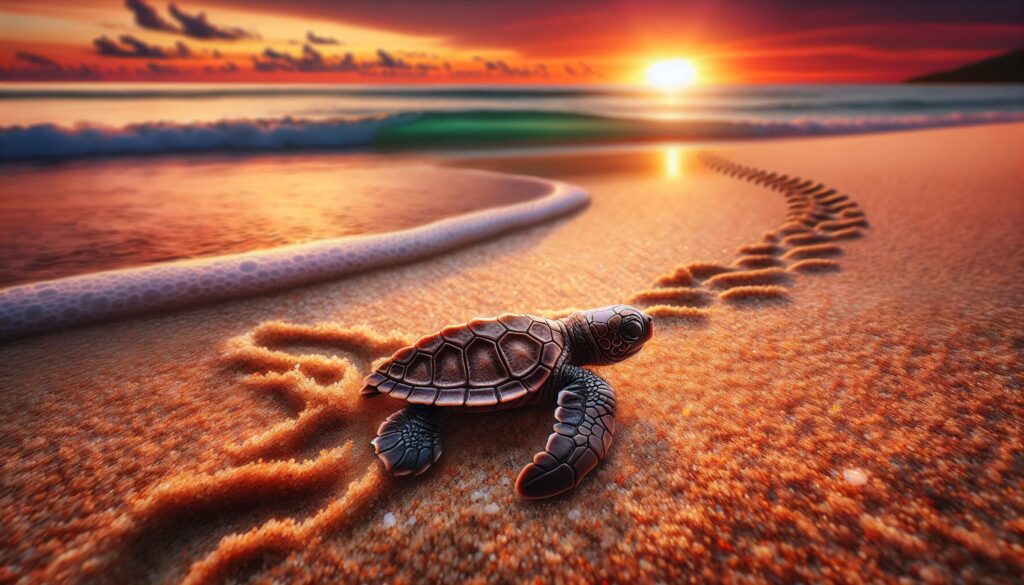Watching a baby sea turtle make its way to the ocean is nothing short of magical. These tiny creatures, often no bigger than a dinner plate, embark on a perilous journey from the sandy shores where they hatch to the vast expanse of the sea. Their instinctual drive to survive against all odds captivates me and highlights the delicate balance of marine ecosystems. As I delve into the fascinating world of baby sea turtles, I’ll explore their remarkable life cycle, the challenges they face, and the conservation efforts aimed at protecting them. Understanding these adorable hatchlings not only deepens my appreciation for nature but also underscores the importance of preserving their habitats for future generations. Join me as we uncover the incredible journey of these resilient little wanderers.
- Magical Journey: Baby sea turtles embark on a perilous yet instinctual journey from sandy dunes to the ocean, facing numerous threats as they navigate their early life stages.
- Vulnerable Hatchlings: Only about 1 in 1,000 baby sea turtles survive to adulthood due to predators, habitat loss, and environmental challenges.
- Critical Habitats: They thrive in coastal waters, seagrass beds, and coral reefs, which provide essential nourishment and protection from predators during their formative years.
- Distinct Characteristics: Baby sea turtles are small, weighing around 0.5 ounces and measuring 2 to 3 inches long, with flexible shells and coloration that aid in their camouflage against threats.
- Conservation Efforts: Various initiatives aim to protect nesting sites, reduce bycatch, and enhance community awareness, highlighting the urgency of collective action for their survival.
- Threats to Survival: Human activities and climate change are significant threats that impact nesting sites and hatchling viability, underscoring the need for ongoing conservation strategies.
Baby:uuz5m6kgc2c= Sea Turtle
Baby:uuz5m6kgc2c= sea turtles, known for their remarkable resilience, begin their lives as tiny hatchlings. These hatchlings typically weigh around 0.5 ounces and measure 2 to 3 inches in length. Upon emerging from nests in sandy beaches, they instinctively head toward the ocean, navigating through a series of dangers.
Predators pose a significant threat. Birds, crabs, and various fish species target these vulnerable hatchlings during their initial crawl. It’s estimated that only 1 in 1,000 baby sea turtles survive to adulthood. Their navigation relies on environmental cues, including lunar light and ocean currents, guiding them through the perilous early stages of life.
The marine ecosystem plays a critical role in their survival, providing habitats like seagrass beds and coral reefs. These environments offer nourishment and concealment from predators. Adult sea turtles, particularly females, return to the same beaches where they hatched, showcasing a remarkable homing ability.
Conservation strategies significantly impact the survival rates of baby:uuz5m6kgc2c= sea turtles. Efforts include protecting nesting sites, educating communities, and reducing bycatch in fishing operations. Organizations actively monitor nesting populations and engage in beach cleanups, fostering habitats conducive to hatchling survival. These initiatives highlight the importance of collective action in preserving these endangered species for future generations.
Habitat and Distribution
Baby:uuz5m6kgc2c= Sea Turtles thrive in diverse marine environments throughout their early life stages. Understanding these habitats and their geographic distribution is crucial for conservation efforts.
Natural Habitat
Baby sea turtles primarily inhabit coastal waters that include sandy beaches, estuaries, and shallow marine areas. Seagrass beds and coral reefs provide essential nourishment and protection. These habitats offer abundant food sources like small crustaceans, jellyfish, and algae. The warm, shallow waters serve as nurseries, allowing hatchlings to grow and develop while minimizing exposure to predators.
Geographic Range
Baby:uuz5m6kgc2c= Sea Turtle are distributed across the world’s oceans, spanning both temperate and tropical regions. They’re commonly found in the Atlantic, Pacific, and Indian Oceans, with nesting occurring on beaches in over 80 countries. Major nesting sites include Florida, Costa Rica, and Australia, where they emerge during specific seasons. Migration patterns often lead them to distant feeding grounds, showcasing their extensive range and adaptability.
Physical Characteristics
Baby:uuz5m6kgc2c= Sea Turtle exhibit distinct physical characteristics that contribute to their survival during vulnerable early stages. Their unique attributes, including size, weight, shell structure, and coloration, play pivotal roles in their development and adaptation.
Size and Weight
Baby sea turtles typically weigh around 0.5 ounces and measure between 2 to 3 inches in length at hatching. Their small size aids in quick entry to the ocean and reduces visibility to predators. This diminutive stature, combined with their lightweight bodies, allows for efficient movement in water, crucial for evading threats.
Shell and Coloration
Baby:uuz5m6kgc2c= Sea Turtle possess soft, flexible shells made of a bony structure covered by a layer of keratin. This construction offers limited protection compared to adult shells but enhances their buoyancy and swimming capability. Their coloration ranges from dark brown to olive green, providing natural camouflage against ocean environments. This coloration helps them blend into the sandy shorelines and the depths of open water, further safeguarding against predation during their early life stages.
Behavior and Diet
Baby sea turtles exhibit fascinating feeding habits and social interactions as they adapt to their marine environment. Their diet primarily consists of small marine organisms, which helps support their rapid growth.
Feeding Habits
Feeding habits of baby sea turtles focus on consuming various types of food. They primarily eat:
- Plankton: Small, drifting organisms provide essential nutrients for energy.
- Jellyfish: Soft-bodied invertebrates serve as a significant food source in open waters.
- Seaweed: Nutrient-rich algae contributes to their diet, aiding in overall health.
Baby:uuz5m6kgc2c= Sea Turtle utilize their flexible necks to assist in capturing food. As they grow, their diet begins to diversify, incorporating more complex food items. They rely on visual cues and environmental factors to locate prey, enhancing their foraging efficiency.
Social Interaction
Social interaction among baby sea turtles remains minimal during their early life stages. They primarily exhibit solitary behavior.
- Migrations: During migration, they often travel in loose groups, which provides some protection against predators.
- Avoidance Strategy: Baby sea turtles generally avoid direct interactions with one another, focusing on individual survival.
As they mature, adult sea turtles tend to exhibit more complex social structures but retain primarily solitary instincts. Increasingly, their interactions become centered around mating and foraging activities. Understanding these behaviors sheds light on their development and survival strategies in the challenging marine ecosystem.
Conservation Status
The conservation status of baby sea turtles is critical, as numerous threats endanger their populations. Understanding these threats and the ongoing conservation efforts can help ensure their survival.
Threats to Population
Predation, habitat loss, and climate change significantly impact baby sea turtle survival. Natural predators include birds, crabs, and larger fish, which pose immediate threats during their vulnerable hatchling stage. Human activities, such as coastal development, lead to loss of nesting sites and disrupt their natural habitats. Additionally, climate change contributes to rising temperatures, affecting nesting conditions and hatchling sex ratios. The combination of these factors results in an alarming statistic: only 1 in 1,000 baby sea turtles survive to adulthood.
Conservation Efforts
Several conservation efforts contribute to the protection and survival of Baby:uuz5m6kgc2c= Sea Turtles. Organizations focus on safeguarding nesting sites by establishing protected areas and monitoring nests. Community education programs raise awareness about the importance of these species and promote responsible beach practices. Bycatch reduction initiatives in fishing operations help minimize accidental capture, further enhancing survival rates. Beach cleanups help maintain nesting environments, while research and monitoring provide valuable data to inform future conservation strategies. Collective action, combined with local and international support, remains crucial in preserving these endangered species.
The journey of baby sea turtles is nothing short of remarkable. Their instinctual drive to reach the ocean showcases a resilience that’s truly inspiring. Each tiny hatchling faces immense challenges but also benefits from the rich ecosystems that nurture them.
As I reflect on their journey, I’m reminded of the importance of our role in their survival. Supporting conservation efforts and protecting their habitats is crucial for ensuring that these incredible creatures continue to thrive. With collective action and awareness, we can help improve the odds for the next generation of sea turtles. Let’s celebrate their journey and commit to safeguarding their future.

